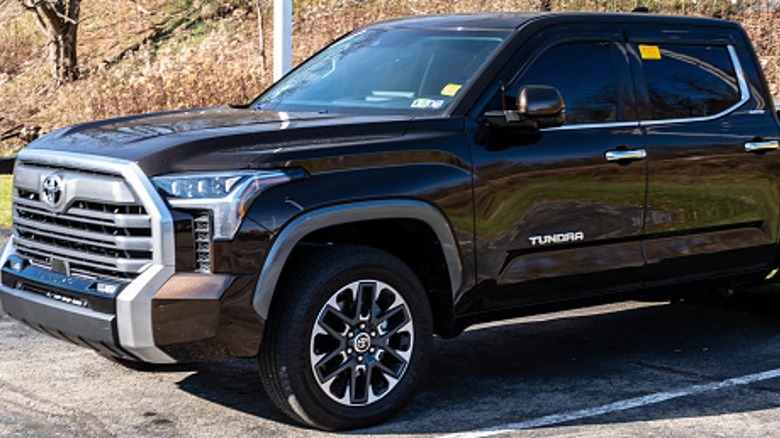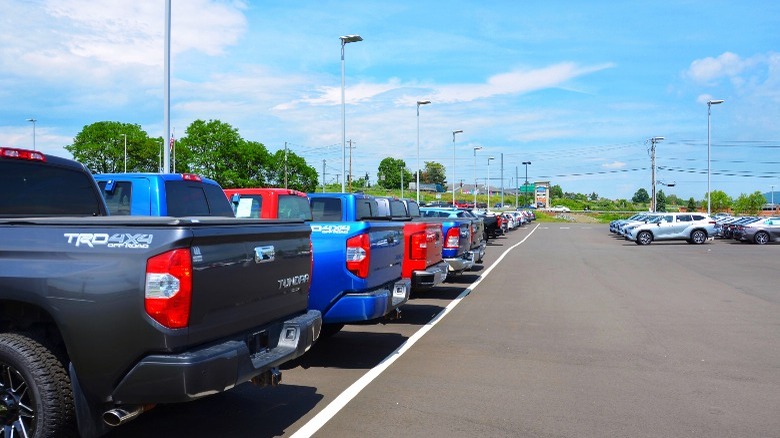Tacoma Vs. Tundra: Which Toyota Truck Is Right For You?
Choosing a truck from Toyota often boils down to one question: the Tacoma or the Tundra? They're both popular, reliable Toyota trucks but offer very different driving experiences. Which one you want will hinge primarily on how much power you need.
Over the past two decades, the trucks have undergone significant changes, but they remain the same at the core. The differences between the two make it so you can't really "replace" one with the other. The Tacoma is small, and the Tundra is big. If you need a cheap reliable truck, you should get yourself a Tacoma, and if you want something bigger with more oomph, get a Tundra.
Comparing these two is similar to comparing the Hilux and the Tundra. Because Toyota doesn't make the Hilux for the U.S. anymore, the Tacoma is essentially what passes for a modern Hilux in America. Tacoma's lighter build and smaller form make it much better for driving trails and maneuvering tricky off-road biomes, much like the Hilux.
What kind of truck is the Toyota Tacoma?
When Toyota introduced the Tacoma in 1995, it replaced the Toyota Hilux (sold as Toyota Pickup in the U.S.). The first generation of Tacoma was called a compact pickup truck, and compact it was, with its in-line four engine, 2,500 lbs curb weight, and an overall length of about 170 inches.
Nowadays, Tacoma is tagged as a mid-size pickup truck. Understandably so, seeing as newer generations of the truck have gotten bigger and heavier. The base 2023 Toyota Tacoma has a DOHC 2.7-liter 4-cylinder engine with VVT-i 159 hp at 5,200 rpm. It does 180 lb-ft of torque at 3,800 rpm. More expensive trims use a 3.5-liter V6 engine with 278 hp and 285 lb-ft of torque at 4,600 rpm. You can also choose between a RWD and a 4WD option.
All these stats mean that you can get a cheap, daily Tacoma with decent mpg that could competently tow a small camper. Or you can opt for a powerful off-roader that could be pricey. The duality of the Tacoma is one of its appeals since its many trim options mean you could find one that works best.
How is the Toyota Tundra different?
Toyota knew some Americans needed more and knew it had to offer something to stand up to Ford's F-150. So, in 1998, Toyota unveiled the T150, and after some stern words from Ford, the Japanese brand changed its name to Tundra. The Tundra first appeared as a full-size V8 with almost 4,000 lbs of curb weight with a length spanning over 200 inches.
Today, the base Toyota Tundra has a 3.5-liter V6 engine with 358 hp and 406 lb-ft of torque. The 2023 Toyota Tundra does not come with a V8 engine. Instead, the more expensive trims are twin turbo V6 engines paired with an electric motor.
Evolving from its decade-old predecessor, it has gotten even bigger. The 2023 Tundra, for instance, is over 230 inches long, 80 inches wide, and boasts over 5,000 lbs of curb weight.
Essentially, the Tundra is a big and powerful pickup truck you could get as an alternative to Ford's exceptionally popular F-150.
How heavy are the things you want to tow and carry?
Pickup trucks are extremely versatile vehicles. But few people will buy a pickup if they don't plan to use it to carry or pull things. Therefore, you must choose your Toyota truck depending on how heavy your load is.
The 2023 Tacoma can tow a maximum of 6,800 lbs. Small boats, mid-sized campers, and jet skis are all within its purview. They also generally come with 5-6 ft beds (depending on your trim), enough space to contain things like furniture. But while loading the truck bed, be careful not to exceed the payload of 1,685 lbs.
In contrast, the 2023 Tundra can tow a maximum of 12,000 lbs. That means heavy machinery, large travel trailers, horse trailers (with horses), and bigger, more luxurious boats. In short, it should meet most non-tractor towing needs competently. It also has longer bed options with some trims offering up to 8.1 ft of long beds.
Interestingly, the maximum payload on the 2023 Tundra is about 1,940 lbs, which means it offers only 255 lbs more carrying strength. The Tacoma might be a more conservative purchase if you plan to carry instead of tow. Keep in mind that these numbers may vary based on trim and model year, so check the fine print carefully.
Do you plan to take your pickup off-road?
While you can technically use either a Tundra or a Tacoma to go off-roading, you'll get the best experience in a TRD Off-Road Tacoma. This trim has the right engine to give you enough power, and the lighter build and maneuverability in a Tacoma also make it superior for those off-grid excursions. It's one of those vehicles ready to go off-roading fresh off the lot.
However, the 2023 TRD Off-Road would probably cost you around $35,000-$40,000, which could be enough to get a base model Tundra. So, unless you're really into off-roading, it might not be worth it. All that money could go into getting a more powerful vehicle that can tow anything you need while still being decent enough for some lightweight off-roading.
You can compromise with cheaper Tacoma trims, but they won't have all the tech Toyota has stuffed into the TRD Off-Road. For instance, only the TRD Off-Road and TRD Pro have off-road-tuned suspension with Bilstein shocks. They are also the only trims with Toyota's Multi-Terrain Select (MTS) and Crawl Control (CRAWL) technologies. These can give you a big edge in your off-roading hobby. If you want to enjoy all of these on a Tundra, you could get it in a TRD Pro trim, but the MSRP is about $70,000. Basically, it's out of budget for most people.
What about comfort, daily driving experience, and fuel efficiency?
The Tundra is bigger than the Tacoma, and that difference in size translates to the cabin. With a Tundra, you get more head space and legroom. You also get leather-trimmed heated and ventilated seats on all trims. You can get more insight into the kind of luxury a Tundra can offer in our 2022 Toyota Tundra Capstone review.
On the flip side, the Tacoma only gets leather-trimmed seats in the Limited and TRD Pro trims. Both of which are as expensive as Tundras, anyway. It's clear Toyota is trying to make the more expensive vehicle more comfortable.
The catch is that the Tundra is so big that fitting it into your garage might be problematic. Its size makes it an unwieldy vehicle to drive through small spaces and navigate cities with tight traffic.
In non-hybrid models, the Tacoma has better mpg. For example, the 2017 Toyota Tacoma 2WD with a 4-cylinder 2.7-liter engine boasts 21 combined mpg while the 2017 Toyota Tundra 2WD 8-cylinder 4.6-liter engine has 16 combined mpg.
When we move to 2023, though, with hybrid engines, the playing field levels. The 2023 Tundra can offer up to 22 combined mpg with a 2WD 6-cylinder 3.4-liter automatic engine. Meanwhile, the best the Tacoma from the same year offers is 21 combined mpg with a 2WD 4-cylinder 2.7-liter automatic engine.
What's the verdict?
Here's the take-home from all of this: the base model 2023 Tundra is perfect for towing, and the TRD Off-Road Tacoma is what you should get if you want to go off-roading.
While the Tacoma can tow, it works best as a vehicle for a lone individual going out on their recreational adventure since they'll tow relatively light items. When you've got a family or a group, and the load increases, all the comfort, power, and features of a Tundra are worth considering. Even better, the 2023 Tundra's hybrid has reduced the fuel efficiency problem.
The Tundra also has some really cool features that make towing easier. It has sensors that automatically detect a trailer's physics, so it helps you keep it straight while you back out of a spot. It also has a blind spot monitor that helps with visual and audio cues so you know when a vehicle is approaching from your trailer's blind spots. These, plus other features the Tacoma already has, make it the better choice if you can afford it.






